RIVER ISSUES IN ECUADOR
Gravel Mining
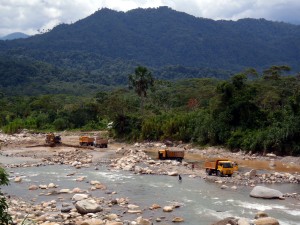 Instream gravel mining for construction materials causes horrendous impacts to rivers and is one of the biggest challenges for river conservation in Ecuador, since sand, gravel, and rock material is the basic building block for all development, and is used for building roads, bridges, homes, buildings, and other infrastructure projects.
Instream gravel mining for construction materials causes horrendous impacts to rivers and is one of the biggest challenges for river conservation in Ecuador, since sand, gravel, and rock material is the basic building block for all development, and is used for building roads, bridges, homes, buildings, and other infrastructure projects.
Indiscriminate mining and dredging of rivers provokes active upstream erosion and headcutting of the river bed, causes the banks and shoreline to erode and collapse, and saturates downstream areas with newly-released sediments and material. These erosional processes completely alter river channels, eliminating natural features like rapids, bends and meanders, and make the river wider, shallower, and warmer. Besides wreaking havoc on the aquatic ecosystem, this can result in massive channel shifts and increases the risks and impacts of flooding.
The ERI encourages the development of modern aggregate mining production facilities in appropriate areas away from rivers. The ERI monitors and documents gravel mining activities in the rivers, engages government mining authorities to uphold existing laws and regulations, and works to educate decision-makers and the local population about the impacts and promote alternatives.
Gold Mining
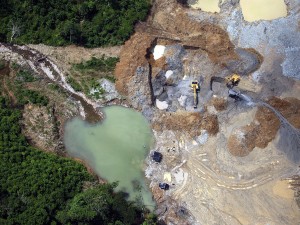 Informal and illegal gold mining is a complex social and environmental problem affecting many rivers in the Amazon basin. Motivated by the high price of gold and the lack of other employment opportunities, small-scale and subsistence gold mining of river sediments and flood plain areas has proliferated and become a leading source of income for the local population.
Informal and illegal gold mining is a complex social and environmental problem affecting many rivers in the Amazon basin. Motivated by the high price of gold and the lack of other employment opportunities, small-scale and subsistence gold mining of river sediments and flood plain areas has proliferated and become a leading source of income for the local population.
Miners use motor-powered suction dredges to work through river bed sediments, blast the river banks with pressurized water to release gold that has been deposited in sediment layers, and use excavating machines to heap bucket-loads of material from the river banks and beaches onto large metal racks equipped with high-pressure water hoses to wash down the material.
These illegal gold mining activities cause serious impacts and contamination. Informal mining camps invade areas along rivers where entire families live beneath plastic shelters without basic services or sanitation facilities. Mining eliminates forests and natural vegetation, and provokes intensive erosion and sedimentation which affects downstream water quality and is highly disruptive to the aquatic ecosystem. Motorized equipment and machinery is used and serviced in or around the rivers, and fuel is stored in inadequate containers. The fuel containers and other wastes are typically left and discarded at the mining sites and eventually end up in the rivers. Loud motors are operated without mufflers, which displaces wildlife and affects the quality of experience for other river users, and conflicts with tourism activities, which offer a sustainable economic alternative. Also, small children work and play in close proximity to the motors without any hearing protection.
The use of mercury in informal and illegal gold mining activities is a serious environmental and public health concern. It is estimated that approximately 50 tons of mercury is released into the environment each year through the amalgamation of gold from informal and illegal mining activities in Ecuador. Once mercury enters an ecosystem it does not break down and persists indefinitely.
Strong leadership is needed to organize and educate the miners and direct the development of mining activities in appropriate areas using the best modern standards and practices, and complying with all mining laws and environmental regulations.
The ERI makes recommendations for improving mining policies, and tries to help strengthen the capacity of government institutions to regulate and control informal and illegal mining activities. The ERI monitors gold mining activities, documenting when new activities start, and developing detailed maps showing where gold mines and access roads are located.
If you invest in gold, please ensure that you are supporting a legitimate mining company and operation that is certified to be compliant with modern standards and practices. If your gold investment portfolio is not certified, you are most-likely supporting illegal mining activities.
Deforestation
Trees and forests are vital for preserving scenic landscapes and biodiversity, regulating water runoff, controlling erosion, and maintaining water quality in rivers. Tropical rainforests in the Amazon region are particularly important for their role in global climate regulation.
Ecuador has one of the highest rates of deforestation in Latin America, and lacks management. About 200,000 Hectares of forests are harvested each year in Ecuador to serve the demand of local and international markets, while only about 5000 Hectares are replanted. The majority of deforestation is driven by illegal logging which accompanies new road construction, agricultural expansion, illegal mining activities, and other development projects which open up previously inaccessible areas. Another level of incipient illegal logging occurs along accessible rivers and existing roads until forests are depleted. Most of the rural population in the Amazon region depends on timber harvesting for at least part of their income, due to the lack of other employment opportunities, and since it is an accessible resource that is always in demand.
The ERI monitors deforestation along rivers, and tries to help government authorities increase their capacity to control illegal logging and develop forestry management programs. The ERI advocates preserving riparian forest corridors along rivers as a key conservation strategy for river protection, and promotes planned, large-scale reforestation projects with native tree species in appropriate areas that have already been intervened and deforested to provide future wood resources.
Hydroelectric Projects
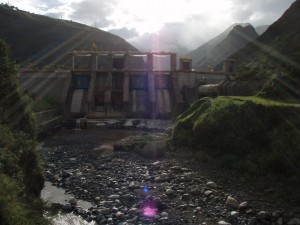 Due to the relative abundance of high-gradient rivers draining from the Andean cordillera, hydroelectricity will always be an important part of Ecuador’s renewable energy portfolio.
Due to the relative abundance of high-gradient rivers draining from the Andean cordillera, hydroelectricity will always be an important part of Ecuador’s renewable energy portfolio.
Ecuador produces about 50% of its electricity from existing hydroelectric projects, and is currently building 8 new hydroelectric projects in an ambitious attempt to be able to generate all of its electricity from renewable energy sources, and not rely on diesel power plants or be dependent on importing electricity from Colombia or Peru to meet its electricity needs.
However, since most hydro projects in Ecuador are designed to operate at full capacity when rivers are at flood stage conditions, and since river flows are rain-dependent and typically maintain relatively low flows except after periods of heavy rainfall, electricity generated from hydro projects is highly variable and vulnerable to local climate patterns and weather trends. The resulting deficits in hydroelectric energy production must be compensated for on a day-to-day basis by thermal electric generating plants which burn fossil fuels, or by importing electricity from neighboring countries.
Due to inherent issues of seismic risk, geologic instability, and high levels of sedimentation, there are few places where large dam structures can be built in Ecuador, which can provide sufficient water storage capacity to regulate the natural variation between high and low river flows. Thus, most hydroelectric projects in Ecuador are dependent on the natural availability of water in the rivers to generate electricity.
The ERI uses objective criteria to evaluate hydroelectric projects and supports the responsible development of hydroelectric projects which demonstrate sound planning, decision-making and best management practices.
The ERI promotes the optimization of existing hydroelectric schemes and the strategic development of hydroelectric projects on rivers of low resource quality that are already intervened, impacted, contaminated, and close to the population centers which drive the demand for electricity, and in places which do not conflict with existing river uses.
Contamination
In 2008-2009, the ERI completed a baseline water quality assessment at over 60 sites on rivers throughout the Napo watershed. In general, water quality is very good in the sections of rivers upstream of cities and communities, but rapidly declines downstream of any significant population center.
More than 90% of the population in Ecuador has no form of sewage treatment, and the waste is discharged directly into rivers. Solid waste management is deficient at all levels, and is mostly limited to open dumps which eventually drain into rivers.
The ERI has worked hard to educate the population, present information about the levels of contamination, appropriate treatment technologies, introduce strategies for improving waste management, and identify sources of funding to make sewage treatment and waste management a priority for government institutions and authorities. Unfortunately, waste treatment infrastructure continues to be marginalized in the development agenda, and many political and cultural barriers still exist before things will change and conditions will improve.
One notable improvement has been the implementation of a 2-cent deposit on plastic beverage bottles at the national level as an incentive for recycling. This program was highly controversial when it began in 2012, but has effectively eliminated plastic bottles from streets, gutters, trash dumps, and rivers. The results of this program are encouraging as it shows that waste management policies can be successfully implemented in Ecuador.
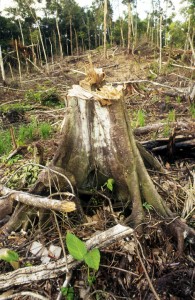
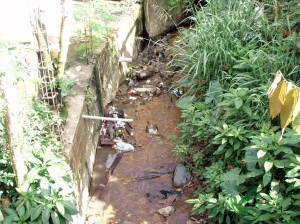
Sorry, i wasn’t able the first time but now I did it.
Good job!
where are the sources?